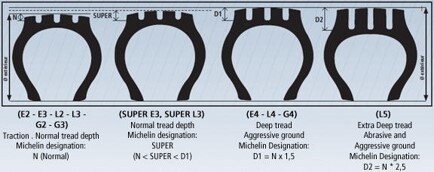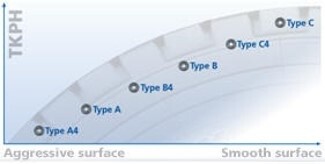
Background photo mine landscape Help and Advice
Choosing the right tires
Choose the right Michelin off-road tire to maximize your performance.

Picto image summary choix pneus Help and Advice
Michelin tread pattern board
Step 1: Define Your Usage
The international classification defines 4 types of use.
The sidewall of a tire indicates which type it belongs to:
- C: Compactor
- E: Earthmoving
- G: Grader
- L: Loader and bulldozer
Choose the right Michelin off-road tire to maximize your performance. Click here for more information.
Step 2: Analyze usage conditions and ground composition

Picto image classification usages elg Help and Advice
Michelin Figure of usages classification
There are different depths and shapes of lugs. The choice of tread type depends primarily on the soil or road surface most used: traction, abrasion and cut risk, rapid wear and tear, etc. Optimum material performance largely depends on the choice of tire:
- 1: Lined (normal tread depth)
- 2: Traction (normal tread depth)
- 3: Normal (normal tread depth)
- 4: Depth (deep tread)
- 5: Very deep (deep tread)
- 7: Flotation (normal tread)
MICHELIN tires are ready for any environment!
Step 3: Know your TMPH
To choose the right tire, you need to know your TMPH. The TMPH (Ton Miles Per Hour) is an essential characteristic of the working capacity of your tires. For the same size and pattern, there may be several types of rubber, each associated with a different TMPH. TMPH and TKPH (Ton Kilometers Per Hour) values are part of the tire characteristics. They depend on the load capacity of each size, the number of miles allowed per hour per tire type, and are given for a standard ambient temperature of 38°C.

Picto image tkph graph Help and Advice
tkph graph
These tips may also interest you:
• Reading the sidewall of an off-road tire
• Mounting and dismounting your tires
• How to store tires properly
• What pressure is needed for off-road tires
• How to inspect maintain your tires
• Repairing off-road tires




